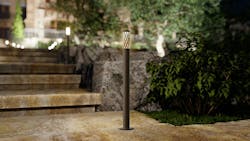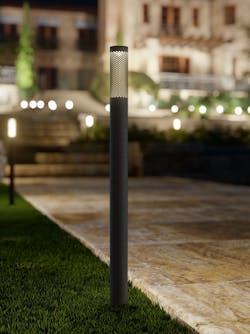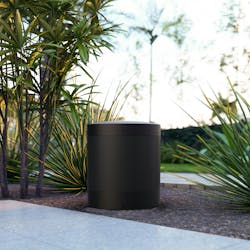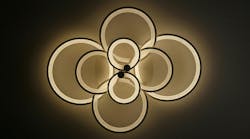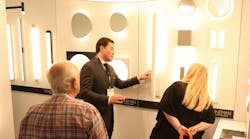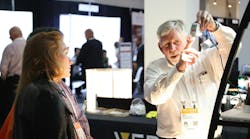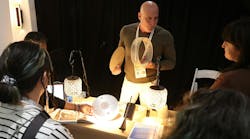Calling its new outdoor lighting series an evolution in terms of miniaturization and light engine, Coastal Source launched the Evo Series lighting line for outdoor installations. At an event at the Apollo/Saturn V Center at Kennedy Space Center on February 24, more than 250 dealers, customers and company team members gathered to learn about the new products and help celebrate Coastal Source’s 15th anniversary.
In advance of the event, Coastal Source co-founder and CEO Franco D’Ascanio and company president Jeff Poggi joined LightSPEC to discuss the evolution of outdoor lighting products, its new speaker bollard, and the company's approach to outdoor lighting. Their answers have been edited.
LS: Tell me about the development process for Evo.
Poggi: Our MR11 and MR16 family of products, which are sort of the standard industry sizes, if you will, have done extremely well for many years. And then we introduced our niche product line a few years ago that was an elegant, small lighting line, and yet was really discreet and had a lot of wonderful integrations in it. And taking these three lines — our MR11, MR16 and our niche product — and putting all of those lessons together, we have Evo.
The Evo starts with the heart of the light engine, where we use a Cree LED. But we take that Cree LED and we fully integrate it into a seamlessly self-contained electrical module that has all of the electronics in it and an integrated cable system. So, you have a fully sealed, fully weather-resistant module that is going to last a lifetime. Evo encapsulates everything we’ve learned in 15+ years in business into this new product, and it is positioned as our new best-in-class.
LS: What are some of the features of Evo?
Poggi: It’s got all of the elements that we’ve learned over the years about managing the thermal aspects.
The biggest reason lights fail is because they are hot. They have inefficiencies in them, and they give off heat. We have this wonderful brass fixture that is fully integrated into the actual module that then connects to these brass fixtures that are used as the heat sink to really take the temperature down on this device, so that it’s going to last a long time. And the hermetically sealed capsule of this module really prevents it from any moisture issues.
And then you take this little module — which is 50% the size of an MR16 — but it outperforms the MR16 light on all of the basic light characteristics. It has more lumens. It has a wider beam angle, even though it is much, much, smaller.
LS: You mentioned that it’s all encapsulated. Do you replace the whole fixture then? Or do you just replace the module when it comes time?
D’Ascanio: Just a module. So, what’s really cool about it is it’s fully integrated. There is nothing that can go wrong with our fixtures. There are no sockets. There are no waterproof seals. They are beautiful brass holders for that lamp that allow you to adjust it, aim it, mount it, and add accessories — shrouds and things like that. They’re beautifully made, but there are no active components.
The other thing I think is very important — that I don’t believe Jeff mentioned — is we have a patented cable system. The traditional lighting is taking a spool of cable, cutting it into pieces, stripping the wire, deciding on what type of waterproof connector to try and use. There are many ways of doing it, but those are all fairly expensive and time-consuming, and they cannot compare to our IP-68, which means a completely submersible connector with gold-plated contacts for extremely low resistance, and direct burial cable with five layers of protection. The number one failure of outdoor lighting is the cabling and connection system.
What were the driving forces behind developing the new line?
D’Ascanio: We are not about sitting on our laurels. We’re just always designing, testing, evaluating failures, and we got to the point where we felt we had a recipe for the next quality line, that really is an addition to what we’re doing.
We felt that we could create a line with a lot of technology and innovation that is a best go-to fixture — unless you’re just looking for a lot less money, you know. So, it did all the things that we couldn’t quite do as well as we wanted with the current existing lines.
Poggi: And if I can add one comment — there is the MR16 line, which is the traditional higher output line that we sell — it’s wonderful, but it’s big. So, if you want to do any artistic or design-focused features or fixtures, you need a smaller LED package to build those around. And so by doing the design integration and creating that custom module that was so small but yet so powerful, not only does it work well when you want to hide it in a bed, but if you want to make it a visible element like the hats, or a hanging light from a tree, other uplights that you may want to be visible, the fixture being so small, just allows you to do things that are more elegantly designed. So now we have this whole new design quotient that is going to be a new and differentiating benefit that we haven’t had before.
LS: Anything specifically you want to share with our architectural lighting audience?
Poggi: For architects, from an architectural point of view, we have a product line that is extremely designer-friendly. And with the Evo product and the 200 configurations [available], the design flexibility to give you exactly the fixture look, but also the light output, you know that you’re looking forward to customizing that landscape environment that you’re designing.
I think we’re well-positioned with architects because we’re also dealer-direct.
Tell me briefly about your new outdoor speaker.
D’Ascanio: I think our outdoor audio is probably about 10 years old. What is common [in a lot of outdoor audio equipment] is either a box speaker on your wall for outdoors, or these plastic bullets and a subwoofer. It produces decent sound, but it doesn’t have true high fidelity.
Outdoors, we have an advantage: We don’t have a room, so we don’t have all these reflections and problems, so we’ve got a great environment. A lot of people listen to music outside more than they do inside. So, there are a lot of reasons to produce a high-fidelity speaker.
The Bollard 1000 Speaker Series is basically a tower speaker, but it can be buried. There are a lot of pieces that go into the speaker, but what will be produced is a very high-fidelity speaker that blends in nicely with the landscape. Each one of our speakers had an integrated subwoofer. Each speaker is a point source — a full-range speaker — so the listening environment, the music, sounds better.
You’ve told us a bit about the secret of your success in the past 15 years, but what’s next for Coastal Source? Where do you see opportunity and where do you see your company evolving?
D’Ascanio: We want to be strictly outdoors, so a lot of our products — some of our lighting products — are used indoors. That is not our target, but we want to continue to expand in outdoor technology and own that outdoor technology. So, a qualified dealer that knows what they’re doing in design, installation, implementation, and maintenance can have this incredible experience that they can offer their customers.
So, it’ll expand beyond light lighting and audio will continue to evolve. We want to bring the quality, the technology, and the enjoyment that our current products bring to the rest of the backyard — outdoor fire, cooling, and possibly high voltage. All the things that are what we see on job sites when we look at the problems — that’s where the opportunities are.
